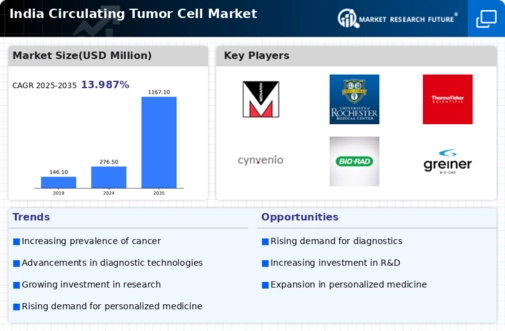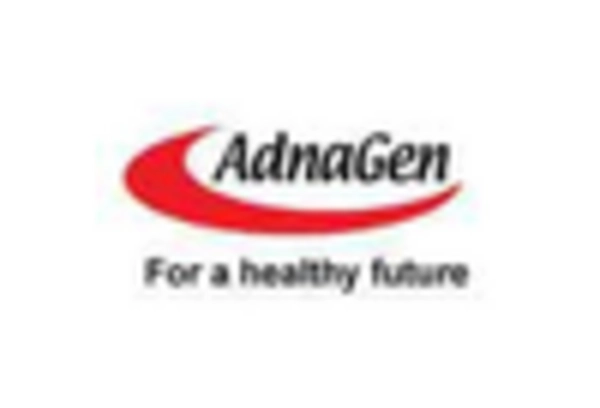Rising Cancer Incidence Rates
The increasing incidence of cancer in India is a primary driver for the circulating tumor-cell market. According to the National Cancer Registry Programme, cancer cases are projected to rise significantly, with estimates suggesting over 1.5 million new cases annually by 2025. This alarming trend necessitates advanced diagnostic tools, including circulating tumor-cell technologies, to facilitate early detection and personalized treatment strategies. The growing burden of cancer is prompting healthcare providers and researchers to invest in innovative solutions, thereby expanding the market. Furthermore, the rising awareness among the population regarding cancer screening and early diagnosis is likely to enhance the demand for circulating tumor-cell technologies, as patients seek more effective and less invasive options for monitoring their health.
Growing Awareness and Education
The growing awareness and education regarding cancer and its treatment options are crucial drivers for the circulating tumor-cell market. Public health campaigns and educational initiatives by both governmental and non-governmental organizations have significantly increased knowledge about cancer screening and early detection. This heightened awareness is likely to lead to an increase in demand for circulating tumor-cell technologies, as patients become more proactive in seeking diagnostic solutions. Furthermore, healthcare professionals are increasingly being trained to recognize the benefits of these advanced diagnostic methods, which could further stimulate market growth. As the population becomes more informed about the importance of early cancer detection, the circulating tumor-cell market is expected to experience a corresponding rise in demand for its innovative solutions.
Supportive Regulatory Framework
A supportive regulatory framework is essential for the growth of the circulating tumor-cell market. The Indian government has been working towards streamlining the approval processes for innovative diagnostic tools, which is likely to encourage the development and commercialization of circulating tumor-cell technologies. Regulatory bodies are increasingly recognizing the importance of these advancements in improving cancer care, leading to more favorable policies and guidelines. This proactive approach not only facilitates quicker market entry for new products but also enhances the overall credibility of circulating tumor-cell technologies among healthcare providers and patients. As regulations evolve to support innovation, the circulating tumor-cell market is expected to benefit from increased investment and interest from both domestic and international stakeholders.
Investment in Research and Development
Investment in research and development (R&D) within the healthcare sector is a significant driver for the circulating tumor-cell market. The Indian government has been actively promoting initiatives to enhance R&D capabilities, with funding allocations increasing by approximately 10% annually. This financial support is aimed at fostering innovation in cancer diagnostics and treatment modalities. As a result, numerous biotech firms and research institutions are focusing on developing advanced circulating tumor-cell technologies. The collaboration between academia and industry is also on the rise, leading to the emergence of novel diagnostic tools that can improve patient outcomes. This trend indicates a robust growth trajectory for the circulating tumor-cell market, as new products and technologies are introduced to meet the evolving needs of healthcare providers and patients.
Technological Integration in Healthcare
The integration of advanced technologies in healthcare is transforming the landscape of cancer diagnostics, thereby driving the circulating tumor-cell market. Innovations such as artificial intelligence (AI) and machine learning are being utilized to enhance the accuracy and efficiency of circulating tumor-cell detection methods. Hospitals and diagnostic centers in India are increasingly adopting these technologies to improve patient outcomes and streamline operations. The potential for real-time monitoring and analysis of circulating tumor cells is particularly appealing, as it allows for timely interventions in cancer treatment. This technological shift is likely to attract investments and partnerships within the healthcare sector, further propelling the growth of the circulating tumor-cell market as stakeholders seek to leverage these advancements for better diagnostic capabilities.
















Leave a Comment